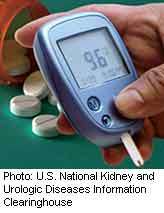Cost of diabetes care in US keeps climbing

(HealthDay)—The total cost of diabetes in the United States jumped from $174 billion in 2007 to $245 billion in 2012, a new report shows.
Last year's total cost included $176 billion in direct medical costs—such as hospital and emergency care, medications and office visits—and $69 billion in indirect costs, including work absenteeism, reduced productivity, unemployment caused by diabetes-related disability and lost productivity due to early death. The 2012 cost represents a 41 percent increase from 2007.
"As the number of people with diabetes grows, so does the economic burden it places upon [the United States]," Dr. Robert Ratner, chief scientific and medical officer at the American Diabetes Association, said in a news release from the association, which commissioned the study.
"When it comes to the rising cost of diabetes, one of the key factors explaining the increase is that there are many more people that are now being treated for diabetes in the U.S.," Ratner explained.
"It is important to note that while treating diabetes is expensive, it is the fact that the prevalence of the disease is increasing dramatically," Ratner added. "Recent estimates project that as many as one in three American adults will have diabetes in 2050. These numbers are alarming, and further highlight the need for our nation to address this epidemic."
Nearly 26 million adults and children in the United States have diabetes and another 79 million have prediabetes, which places them at increased risk for developing the disease.
"The cost of diabetes is rising at a rate higher than overall medical costs, with more than one in 10 health care dollars in the country being spent directly on diabetes and its complications, and more than one in five health care dollars in the U.S. going to the care of people with diagnosed diabetes," Ratner noted.
The study also found that medical costs for people with diabetes are 2.3 times higher than for those without diabetes, and that the primary cause of increased costs is the increasing number of people with diabetes.
Despite the introduction of new medications for the disease, diabetes drugs and supplies accounted for only 12 percent of the medical costs in both 2007 and 2012.
Among the other key findings:
- Most (62 percent) of the cost for diabetes care in the United States is provided by government insurance (including Medicare, Medicaid and the military). The rest is paid for by private insurance (34 percent) or by the uninsured (3 percent).
- Total per-person health costs are higher among women than men ($8,331 versus $7,458), and lower among Hispanics ($5,930) than among whites ($8,101) and blacks ($9,540).
- The per-person cost of medical care attributed to diabetes was $6,649 in 2007 and $7,900 in 2012, a 19 percent increase. Overall, medical care costs in the United States rose by a comparable amount during the same time period, which indicates that the increasing cost of diabetes care is being driven by the increasing number of people with diabetes.
- Among states, California has the largest population with diabetes and thus the highest costs, at $27.6 billion. Florida's total population is fourth among states behind California, Texas and New York, but it is second in diabetes-related costs at $18.9 billion.
More information: The U.S. National Institute of Diabetes and Digestive and Kidney Diseases offers a diabetes prevention series.
Health News
Copyright © 2013



















